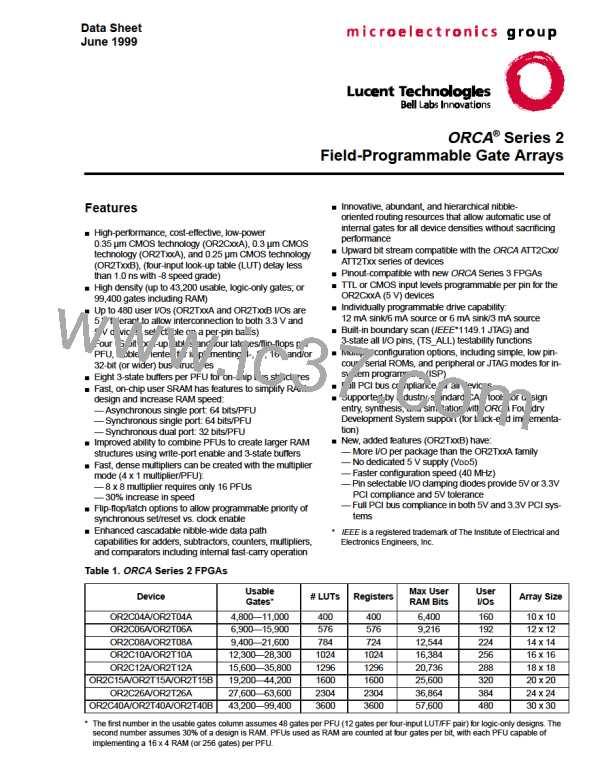Data Sheet
June 1999
ORCA Series 2 FPGAs
Table 16. dc Power for 5 V Tolerant I/Os for
Estimating Power Dissipation (continued)
OR2TxxA deviced
OR2T15A Clock Power
Device
PTOL (VDD5 = 5.25 V)
P
= [0.34 mW/MHz
2T04A
2T06A
2T08A
2T10A
2T12A
2T15A
2T26A
2T40A
1.7 mW
2.0 mW
2.4 mW
2.7 mW
3.0 mW
3.4 mW
4.0 mW
5.0 mW
+ (0.17 mW/MHz – Branch) (# Branches)
+ (0.01 mW/MHz – PFU) (# PFUs)
+ (0.003 mW/MHz – SMEM_PFU)
(# SMEM_PFUs)] fCLK
For a quick estimate, the worst-case (typical circuit)
OR2T15A clock power ≈ 5.9 mW/MHz.
OR2T26A Clock Power
P
= [0.35 mW/MHz
The ac power dissipation from an output or bidirec-
tional is estimated by the following:
+ (0.19 mW/MHz – Branch) (# Branches)
+ (0.01 mW/MHz – PFU) (# PFUs)
+ (0.003 mW/MHz – SMEM_PFU)
(# SMEM_PFUs)] fCLK
2
POUT = (CL + 8.8 pF) x VDD x F Watts
where the unit for CL is farads, and the unit for F is Hz.
For a quick estimate, the worst-case (typical circuit)
As an example of estimating power dissipation,
suppose that a fully utilized OR2T15A has an average
of three outputs for each of the 400 PFUs, that all
20 clock branches are used, that 150 of the 400 PFUs
have FFs clocked at 40 MHz (16 of which are operating
in a synchronous memory mode), and that the PFU
outputs have an average activity factor of 20%.
OR2T26A clock power ≈ 8.3 mW/MHz.
OR2T40A Clock Power
P
= [0.37 mW/MHz
+ (0.23 mW/MHz – Branch) (# Branches)
+ (0.01 mW/MHz – PFU) (# PFUs)
+ (0.003 mW/MHz – SMEM_PFU)
(# SMEM_PFUs)] fCLK
Twenty inputs, 32 outputs driving 30 pF loads, and
16 bidirectional I/Os driving 50 pF loads are also gen-
erated from the 40 MHz clock with an average activity
factor of 20%. The worst-case (VDD = 3.6 V) power dis-
sipation is estimated as follows:
For a quick estimate, the worst-case (typical circuit)
OR2T40A clock power ≈ 12.4 mW/MHz.
The power dissipated in a PIC is the sum of the power
dissipated in the four I/Os in the PIC. This consists of
power dissipated by inputs and ac power dissipated by
outputs. The power dissipated in each I/O depends on
whether it is configured as an input, output, or input/
output. If an I/O is operating as an output, then there is
a power dissipation component for PIN, as well as
POUT. This is because the output feeds back to the
input.
PPFU = 400 x 3 (0.08 mW/MHz x 20 MHz x 20%)
= 384 mW
PCLK = [0.34 mW/MHz + (0.17 mW/MHz – Branch)
(20 Branches)
+ (0.01 mW/MHz – PFU) (150 PFUs)
+ (0.003 mW/MHz – SMEM_PFU)
(16 SMEM_PFUs)] [40 MHz]
= 212 mW
The power dissipated by an input buffer (VIH = VDD –
0.3 V or higher) is estimated as:
PIN
= 20 x [0.09 mW/MHz x 20 MHz x 20%]
= 7 mW
PIN = 0.09 mW/MHz
The 5 V tolerant input buffer feature dissipates addi-
tional dc power. The dc power, PTOL, is always dissi-
pated for the OR2TxxA, regardless of the number of
5 V tolerant input buffers used when the VDD5 pins are
connected to a 5 V supply as shown in Table 16. This
power is not dissipated when the VDD5 pins are con-
nected to the 3.3 V supply.
PTOL = 3.4 mW
POUT = 30 x [(30 pF + 8.8 pF) x (3.6)2 x 20 MHz
x 20%]
= 60 mW
PBID = 16 x [(50 pF + 8.8 pF) x (3.6)2 x 20 MHz
x 20%]
= 49 mW
TOTAL = 0.72 W
64
Lucent Technologies Inc.

 ETC [ ETC ]
ETC [ ETC ]